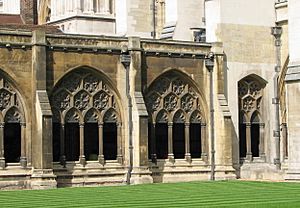Sulcard facts for kids
Sulcard was a Benedictine monk who lived around the year 1080. He worked at Westminster Abbey in London. Sulcard is famous for writing the very first history of this important abbey.
Contents
Who Was Sulcard?
Not much is known about Sulcard's early life. His name is unusual, and it might mean he had either Anglo-Saxon or Norman parents. He probably joined the monastery in the 1050s. It's possible he worked at the cathedral priory in Rochester before joining Westminster. He wrote a lot about Rochester in his history.
Sulcard's Big Book: Prologus de Construccione Westmonasterii

Sulcard wrote only one known book. It's called the Prologus de Construccione Westmonasterii. This long Latin title means "Prologue concerning the Building of Westminster." He wrote it around 1080. He dedicated it to Abbot Vitalis of Bernay, who was in charge of the abbey then.
The book tells the story of Westminster Abbey. It starts with the very first church built on what was then Thorney Island. This was in the early 600s. A rich Londoner and his wife built it. The history ends with the dedication of a new church. King Edward the Confessor (who ruled from 1042 to 1066) built this church for the monastery.
Sulcard wrote that he wanted his book to be a "commemorative book" for his abbey. He especially wanted to promote the worship of St. Peter. St. Peter is the abbey's patron saint. The story says St. Peter himself appeared in the 7th century. He supposedly dedicated the first church in person.
Copies of the History
Two copies of Sulcard's history still exist today. The oldest copy is from a chartulary (a book of copies of important documents) from Winchester. It was made around the year 1300. The other copy is also very old. The title of the book, Prologus de Construccione Westmonasterii, was not the original title. It came from the heading in the older chartulary.
What Makes the Book Important?
Sulcard's story is quite straightforward. It doesn't have many extra details or fancy additions. But it does share local stories about St. Peter's miracle. The book is valuable because it shows how people remembered King Edward the Confessor. This was just a few decades after the Norman Conquest.
Sulcard used another important book as a source. This was the anonymous Vita Ædwardi Regis ("Life of King Edward"). This shows that the "Life of King Edward" existed by 1084 or 1085. Sulcard's copy might have been the same one used by Osbert de Clare later. It was also used by the historian Richard of Cirencester in the 14th century.
Unlike Osbert de Clare, Sulcard did not write about any miracles performed by King Edward. This suggests that at Westminster, Edward was not yet seen as a saint who performed miracles. Edward's role in Sulcard's book is smaller. But he is still remembered as a great ruler. Sulcard wrote that when Edward died, "not only England but also all other neighbouring kingdoms gave way to tears."
A special version of the text was published in 1964. It was put together by Bernard W. Scholz. Parts of the text related to the Vita Ædwardi Regis have also been translated. This was done by Frank Barlow.
Sulcard's Final Resting Place and Lasting Impact
Later stories say that Sulcard was given the special honor of being buried in the abbey's cloister. King Henry III (who ruled from 1216 to 1272) later had Sulcard's remains moved. They were placed in the abbey's newly built chapter house.
Sulcard's book, the Prologus, continued to be read for hundreds of years. The monk John Flete (who died in 1466) used it a lot. He used it when he wrote his own History of Westminster Abbey.

